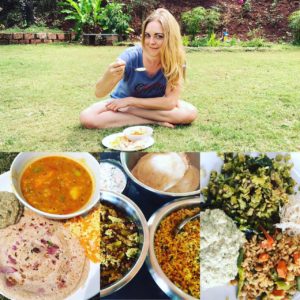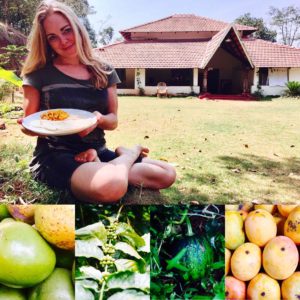Food for Thought
Ashtanga and Fuel
by Philippa Asher
I went to a very exclusive boarding school in the South of England, where many kids with famous parents (and a few regular souls) were given a rigorous vocational training in dance, theatre and music. When I was admitted to the local hospital at fifteen with a large breast lump, the nurses were expecting to see Jane Asher, brandishing a fancy cake. It was my Dad who appeared and swiftly relocated me to a private hospital, in Leicester. At first my breast specialist was very dismissive, but quickly changed his tune after examining me. I was in theatre the following day. It was 1986.
As a tiny child I couldn’t understand why anyone would willingly eat animals. I preferred peas and potatoes. When my specialist advised that some recent studies had suggested that eating animal products can increase one’s propensity to become susceptible to certain diseases, I was overjoyed to announce to the world that I was now ‘officially’ a vegetarian. I never liked cream, yogurt, butter or milk, but cheese … when I reminisce about boarding school cuisine I remember chunks of cheddar on everything and buying Cadbury’s Dairy Milk for 12p a row (yes, we had dealers). My other big food memory was frequent midnight feasts where we would quaff lashings of ginger beer and devour Maltesers, Hula Hoops, Chocolate Fingers, Twiglets and Primula cheese spread. Suffice to say that at ballet school in the early Eighties, we were not educated about the effects on the body, of what we imbibe.
Although I wasn’t mature enough to be mindful about what I allowed into my inner temple at University, I did begin to read books on plant-based diets. I swallowed the facts, but it took a few more years for them to marinade enough, for me to fully digest them. A nugget from Hippocrates would also resonate with me some years later … “Let food be thy medicine and medicine be thy food.”
In the late 1990s the Ashtanga yoga practice found me / rescued me. Like most people I was initially attracted to the physical aspect and loved the fun shapes and feeling of euphoria. What I didn’t anticipate was that I needed to become a Rolls Royce, that could drive from Land’s End to John O’Groats, without stopping. My current Austin Allegro body was likely to lose its wheels.
I was weak, so needed to start putting high quality fuel into my engine if I wanted it to perform well. I realised that that my diet of lager, crisps and baguettes wouldn’t take me very far. I re-read my books on foods that harm and foods that heal and decided to take having a plant-based diet seriously, but this time focusing on nutrition. I began avoiding processed foods as much as possible and items that had a lot of additives, or preservatives – also anything that was genetically modified, contained steroids, hormones, pesticides, chemicals (and kept my allopathic drug-taking to a minimum). I then cut back on refined foods like white flour and white sugar and deep fried delicacies loaded with saturated fat. I started using extra virgin olive oil and coconut oil for cooking and experimented with nuts, seeds, beans, pulses and legumes. Obviously fresh fruit and vegetables became a staple in my diet, as did healthy grains like red rice, quinoa and millet. Balance was what I was interested in, a healthy diet which would give me optimum efficiency from all key food groups. A diet that would encourage my body and mind to perform to the best of their ability.
Guruji moved me through the asana practice fairly quickly and thankfully my body responded well. I started to develop strength and stamina and was able sustain my epic three hour practice, before I was ‘split’ in the Advanced B Series. One conference about twelve years ago, Guruji did announce to me “YOU, must take milk and ghee”. He never knew about my history, or my diet. I sometimes wonder if he was referring to my fertility and had insight into something I could not have anticipated.
The yoga practice teaches us about ahimsa (non harming), which includes not harming ourselves with a toxic diet, or one that might lead to type two diabetes, or heart disease for example. My surgeon in 1986 was very progressive when he suggested that for me, having an animal-based diet might be harmful. We also learn about saucha (cleanliness) in the practice, which doesn’t just mean being physically clean, but also refers to removing ourselves from toxic situations and putting junk inside our inner temples. Some of the Ashtanga food fads are quite curious to me, cutting out onions and garlic (which are incredibly healing and have anti-inflammatory qualities) and buzzing out on gallons of coffee, sugar, refined flour goods, white rice and dairy products. Each to his own of course, but part of the practice is self-enquiry and discovering what is physically (as well as emotionally and spiritually) healthy for us.
Food is fuel, but it’s also fantastic when it’s delicious, nutritious and fun! That’s our aim with the cuisine at ASHTANGA NIRVRTA, our homestay Ashtanga yoga retreat in India. After asana practice we devour an abundance of mouth-watering tropical fruit, some of which we grow ourselves. There are also fresh coconuts and of course the naughty stuff (incredible home-grown, fresh coffee). Brunch is tasty and wholesome South Indian breakfast: red rice and dal idlis, sambar, coconut chutney, multi-grain dosas, with groundnut chutney, neer dosas, bean and chickpea curries, lemon rice, paddu and as a special treat, masala vada. For dinner we indulge in South Indian vegetarian thali-style dishes such as local vegetable curries, thoran, salads, red rice, akki /ragi and beetroot rotis, dal, channa, rajma and papad. Chikki and organic raw chocolate invariably find their way to the banquet table before bedtime too. So far all our guests adore the delicious fare that is prepared with love, by our local South Indian ladies and flourish on the fresh, vibrant dishes.
Although I thrive on a plant-based diet and it has enabled my body to journey happily through four Ashtanga Series, I would never dream of assuming that other people will, or would even want to. My family are all carnivores and so are most of my closest friends. We’re all unique and our bodies behave and react differently to all kinds of things. I do believe though, that the more in tune we are with our optimum mental and physical state, the better decisions we can make about what works for us. I love nothing more than having a few glasses of decent red wine with friends, but I also know that I won’t be running a marathon the next day if I do. Ultimately the yoga practice is about having a healthy balance, joy, awareness, kindness and a sound attitude to life and this not only manifests itself in how we choose to lead our lives, but also what we decide to nourish ourselves with, physically and emotionally. We are what we eat and for the most part I enjoy a satvic light, clean, healthy, fresh organic diet prepared with love, but I also indulge in a dash of rajas (fresh coffee, onions and spice) and try my best to keep tamas to a minimum (the odd glass of wine and beer) …
As the razor sharp and discerning Oscar Wilde said in A Woman of No Importance, “After a good dinner one can forgive anybody, even one’s own relations.”
Written for ‘Ashtanga Magazine’ published 2016
© 2016 Philippa Asher


